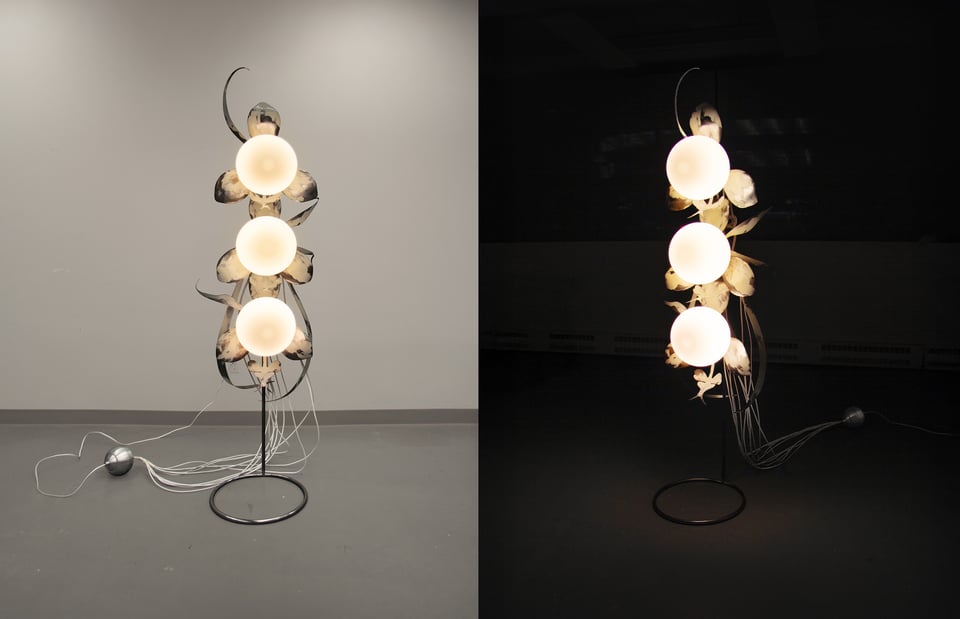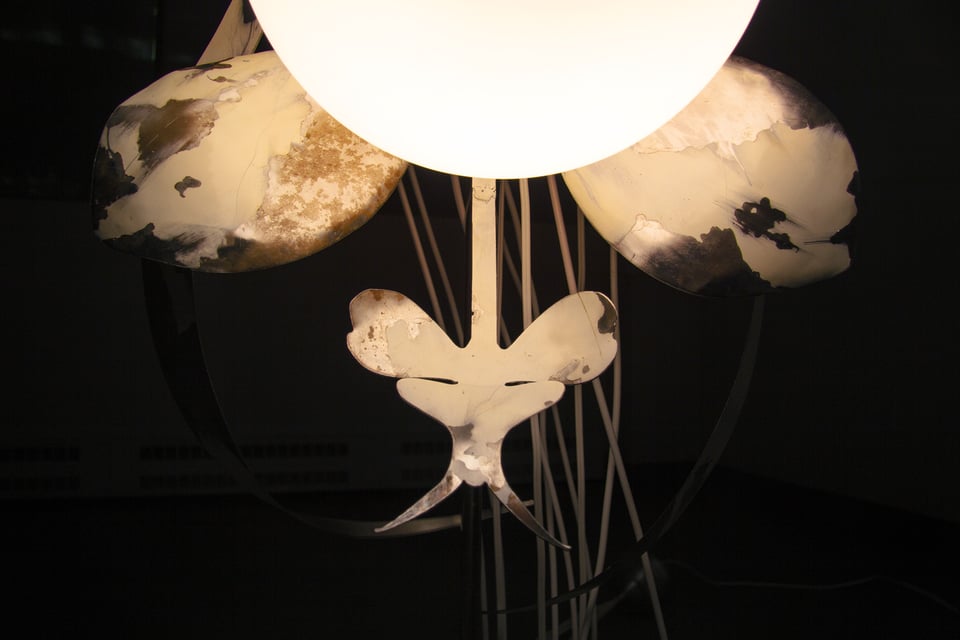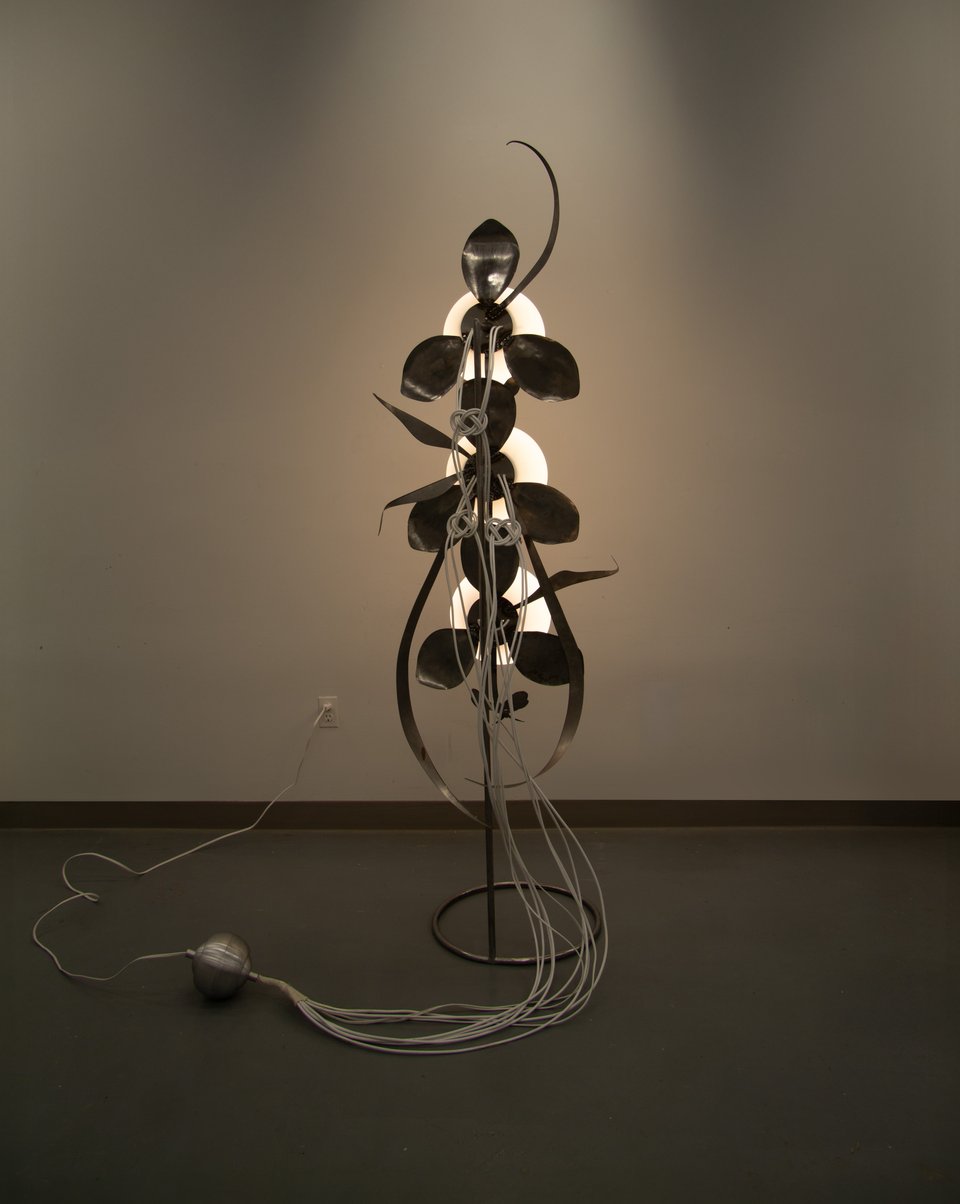Debris from a Lost Future
Field Report 11.05.25

There’s a moment in Crash (1973) by J.G. Ballard where the narrator describes the surface of a car after an accident; the way it bends, crumples, bears the evidence of impact.
The bodies of plastic mannequins sat in the crumpled hulls, their faces and chests splintered by the collisions, wound areas marked in coloured panels on their skulls and abdomens. Helen stared at them through the empty windshields, almost as if they were patients whom she hoped to treat.
Reading Crash I felt a bond with the car-wreck fetishists, a shared fascination with marred metal and the lingering presence of violent events. This sculpture, standing 7.5 feet tall, is deliberately rusted, scratched, and distressed. The petals of metal extrude outward, bearing worn paint and injured steel underneath, hinting at an event, or recurrence of one, that has already passed. Ballard regards this presence as a hypnotic repetition of trauma. “A new sexuality, born from a perverse technology.”
The erotic terms of this new sexuality are technical. No asshole or cock or pussy, only anus and penis and vagina. No cum, only discharge - all sex made motoric. All visual signs fused together in the wreckage. The automobile and its crashing become the only language of the real. The death-drive is the self-destructive lever. It embodies (or disembodies) the desire to return to the inorganic, to not be. It opposes the erotic instinct towards life, towards creation. Though, when the body is given prosthesis, through screens or new machines, the latter incestuously encroaches on the former, and the result is something unique, undomesticated. The idea of death is so sexy and/or mediated by technology that its visual signs, of its loss or effect, are laundered way before they reach us. La petite mort - singular meeting of adjective and noun. Has old technology ever felt haunted to you? Has it ever felt feminine? Not the sleek and impeccably submissive software of Siri or online Google chat-bots, but a baroque hardware of dismemberment and mutilated bodies?
From the R.Y.F.F reading list is Baudrillard’s Simulacra and Simulation (1981): work where language as form overrides language as function - or maybe it’s the other way around. Either way all that is real becomes hyperreal and all that is lost is recuperated when made electric. Through a phone screen, the panopticon of history is readily available - the visual signifiers of each era worth as much the next. Politics are infantilised, political projects subsumed into product-lines. Baudrillard calls Crash the only science-fiction work projected from the conditions of our own reality. I’d think we could try more, find a real elsewhere. Baudrillard means only this: all futures are rendered products of consumption, just as all pasts are subsumed into their historical vibe by the machinery of capital. Any hope and desire can be made property, hermetically sealed futures that can be bought and sold and traded between us as manifold infantilised options.
These items frequently bought together.
The techno-politics of Night Light is the sense of injustice planted into its machinery. Modernity operates on a distinction between human subject and inanimate object, and yet neoliberal capitalism asks of the human experience a fundamental for-profit utility, as it might ask of an automaton working the assembly line before it outlives its value and is finally recycled for scraps.
The market freedom promised by global neoliberalism results in an accumulation of both private wealth and a monopolisation of the imagination. Its impossible to project ourselves forward, to imagine a time that comes out of the times were living in. There are only the scattered and lost futures we recuperate.
The ones that came from somewhere real?
The ones that came from a time when there was real.

I’m interested in what gets revealed in the aging of a machine. Where Crash eroticizes the site of collision, I try to approach it as a kind of quiet intimacy. The rust, the abrasion, the worn paint; they are not aesthetic choices for their own sake, they are invitations to misread time. The implied history here imbues a subtle storytelling and questioning of events: Is this object damaged from use, neglect, violence? Or simply age? We don’t know– that’s the point. It’s an object suspended in the hauntological haze Mark Fisher called “lost futures”-- the debris of our imaginations. Political realities collapsing under the enduring un-reality of capitalism.
The tangible quality of something out of time is key here. This artifact situates viewers in a future that has already happened. Futuristic aesthetics have become a hellscape for LARPing and convoluted stylistic references just like every other fanbase or social movement has. As Mark Fisher writes in Ghosts of my Life (2014), "The ‘futuristic’ in music has long since ceased to refer to any future that we expect to be different; it has become an established style, much like a particular typographical font." It’s a style now. A trace. Ironically, futurism is hardly in fashion anymore. Polished chrome maximalism and 90’s rave wear are already on its way out. Futuristic aesthetics in the mainstream have never had any real roots in political ideology or social change. At some point, though, all the conditions existed.
Night Light exists as an artifact from this imagined time. A future that was abandoned halfway through– its aesthetic language glitching between brutalism, ceremony, and decay. Its wires are bound in the Josephone/Awaji knot– a cross-cultural symbol of unity and eternity– and sheathed in leather before resolving inside a small chrome orb. Moved by contradictions– the industrial and the human, the artificial and the organic– this tension plays in the subtleties of post-industrial storytelling. Not world-building in the utopian sci-fi sense, but world-remembering, a folding in of time, as what has already passed mingles with what is happening and what could be to create a suspended moment of wonder and unease.

The tension breeds sadness. A melancholy that rubs off of the collision between imagined futures and lived reality. Derrida would say we’re haunted. Post-scarcity utopias, flying cars, daydreams bleeding into the cheapness of our world like residue at the bottom of a wine glass. Planned obsolescence, the downgrading of all public technology, the slashing of social programs, the steady digestion of the machinery of capital. Scarred steel, increasingly extreme systems of labour, and self-induced mutilations just to feel something.
Night Light sits with you in the debris. We must be concerned not just with the future but with its perversions. In the steel petals and soft glow, I hope you feel it. That flicker of technological mourning. That buzzing tension between human hands and machine skin. That longing for a new kind of intimacy, a growing unrest, a reconceived future bearing marks of wear. We rust because we were touched.
Kayt “Tech” Meraw is a cyberartist based in Montreal. Get in touch at techmeraw@gmail.com
Elliot Mann is a writer and researcher living in Paris. Reach him at elliot.l.mann@proton.me
